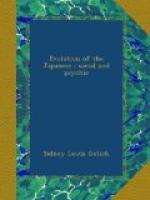But this characteristic is not peculiar to Japan. China and India are likewise marked by it. During the famines in India, it was frequently remarked how the Hindus would settle down to starve in their huts in submission to fate, where Westerners would have been doing something by force, fighting even the decrees of heaven, if needful. But it is important to note that this characteristic in Japan is undergoing rapid change. The spirit of absolute submission, so characteristic of the common people of Old Japan, is passing away and self-assertion is taking its place. Education and developing intelligence are driving out the fear of fate. Had our estimate of the Japanese race character been based wholly on the history of Old Japan, it might have been easy to conclude that the spirit of submission to rulers and to fate was a national characteristic due to racial nature; but every added year of New Japan shows how erroneous that view would have been. Thus we see again that the characteristics of Japan, Old and New, are not due to race nature, but to the prevailing civilization in the broadest sense of the term. The religious characteristics of a people depend primarily on the dominant religious ideas, not on the inherent religious nature.
XXVIII
SOME RELIGIOUS PRACTICES
Among the truly religious sentiments of the Japanese are those of loyalty and filial piety. Having already given them considerable attention, we need not delay long upon them here. The point to be emphasized is that these two principles are exalted into powerful religious sentiments, which have permeated and dominated the entire life of the nation. Not only were they at the root of courage, of fidelity, of obedience, and of all the special virtues of Old Japan, but they were also at the root of the larger part of her religion. These emotions, sentiments, and beliefs have built 190,000 Shinto shrines. Loyalty to the daimyo was the vital part of the religion of the past, as loyalty to the Emperor is the vital part of the popular religion of to-day. Next to loyalty came filial piety; it not only built the cemeteries, but also maintained god-shelves and family ancestral worship throughout the centuries. One of the first questions which many an inquirer about Christianity has put to me is as to the way we treat our parents living and dead, and the tombs and memories of our ancestors. These two religious sentiments of loyalty and filial piety were essential elements of primitive Shinto. The imported religions, particularly Confucianism and Christianity, served to strengthen them. In view of the indubitable religious nature of these two sentiments it is difficult to see how anyone can deny the name of religion to the religions that inculcate them, Shinto and Confucianism. It shows how defective is the current conception of the real nature of religion.




